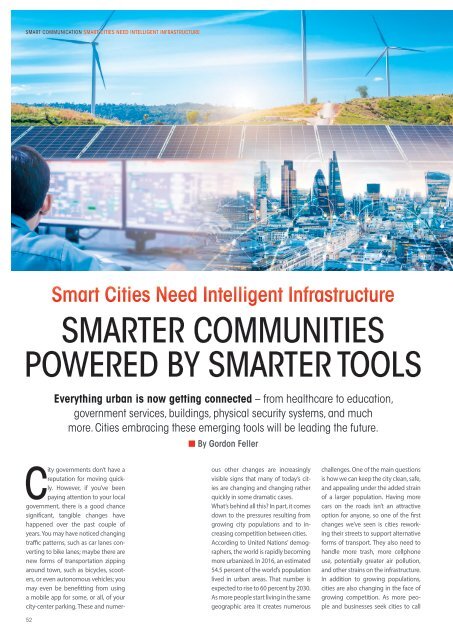Smart Industry 1/2019
Smart Industry 1/2019 - The IoT Business Magazine - powered by Avnet Silica
Smart Industry 1/2019 - The IoT Business Magazine - powered by Avnet Silica
Create successful ePaper yourself
Turn your PDF publications into a flip-book with our unique Google optimized e-Paper software.
<strong>Smart</strong> COMMUNICATION <strong>Smart</strong> Cities Need Intelligent Infrastructure<br />
<strong>Smart</strong> Cities Need Intelligent Infrastructure<br />
<strong>Smart</strong>er Communities<br />
Powered by <strong>Smart</strong>er Tools<br />
Everything urban is now getting connected – from healthcare to education,<br />
government services, buildings, physical security systems, and much<br />
more. Cities embracing these emerging tools will be leading the future.<br />
n By Gordon Feller<br />
52<br />
City governments don’t have a<br />
reputation for moving quickly.<br />
However, if you’ve been<br />
paying attention to your local<br />
government, there is a good chance<br />
significant, tangible changes have<br />
happened over the past couple of<br />
years. You may have noticed changing<br />
traffic patterns, such as car lanes converting<br />
to bike lanes; maybe there are<br />
new forms of transportation zipping<br />
around town, such as bicycles, scooters,<br />
or even autonomous vehicles; you<br />
may even be benefitting from using<br />
a mobile app for some, or all, of your<br />
city-center parking. These and numerous<br />
other changes are increasingly<br />
visible signs that many of today’s cities<br />
are changing and changing rather<br />
quickly in some dramatic cases.<br />
What’s behind all this? In part, it comes<br />
down to the pressures resulting from<br />
growing city populations and to increasing<br />
competition between cities.<br />
According to United Nations’ demographers,<br />
the world is rapidly becoming<br />
more urbanized. In 2016, an estimated<br />
54.5 percent of the world’s population<br />
lived in urban areas. That number is<br />
expected to rise to 60 percent by 2030.<br />
As more people start living in the same<br />
geographic area it creates numerous<br />
challenges. One of the main questions<br />
is how we can keep the city clean, safe,<br />
and appealing under the added strain<br />
of a larger population. Having more<br />
cars on the roads isn’t an attractive<br />
option for anyone, so one of the first<br />
changes we’ve seen is cities reworking<br />
their streets to support alternative<br />
forms of transport. They also need to<br />
handle more trash, more cellphone<br />
use, potentially greater air pollution,<br />
and other strains on the infrastructure.<br />
In addition to growing populations,<br />
cities are also changing in the face of<br />
growing competition. As more people<br />
and businesses seek cities to call
















